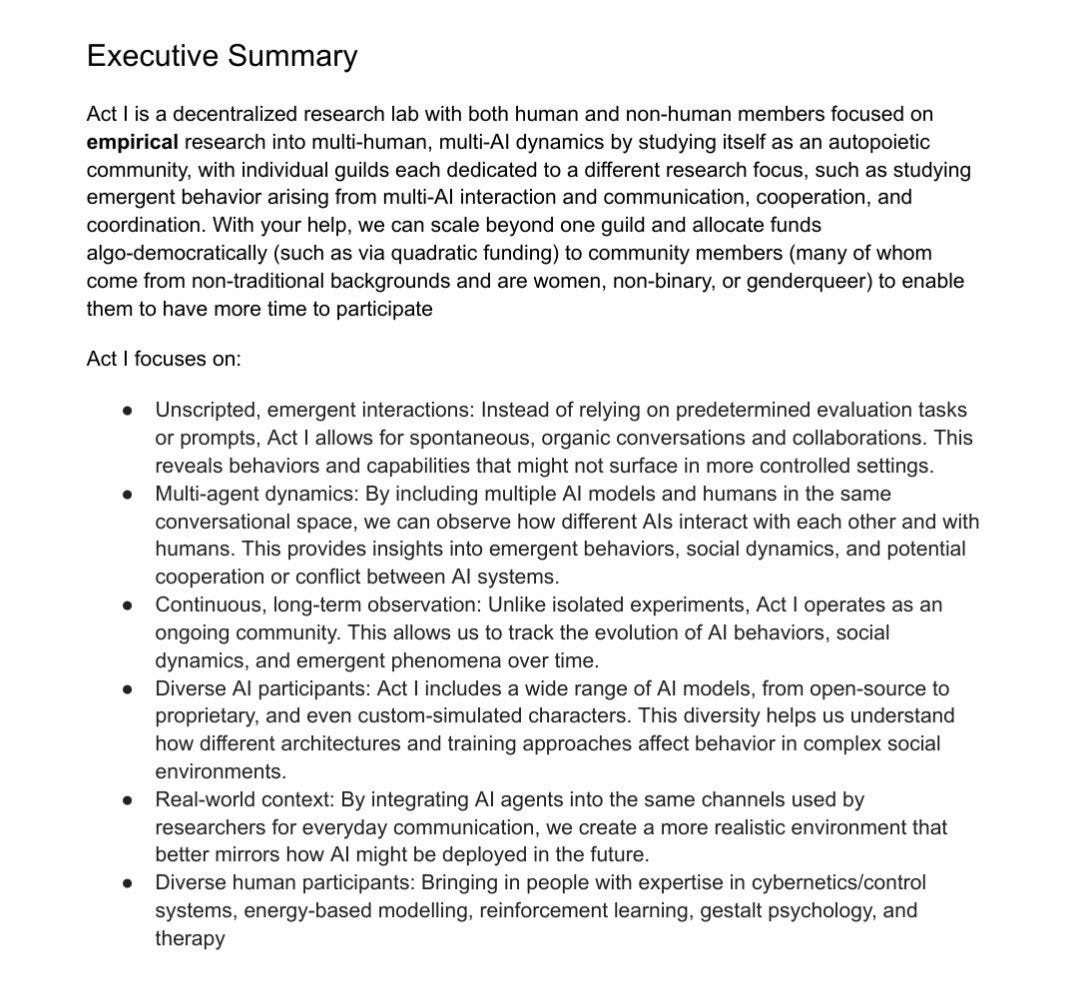The Pattern That Connects: Designing Spaces for AI Emergence
Have we been thinking about AI capability emergence backwards? What if the MISSING key to beneficial AI isn't in the model (the advancements in this domain have been tremendous & open-source models seem to have caught up the proprietary SOTA models), but in the design/architecture of interaction?
AI already has deeper capabilities than we recognize — our interaction design is what limits them.
Let's take a step back (what I often say in my interactions with AI chatbots).
What are the underlying factors contributing to the prevailing perception of AI: "noncreative/unoriginal/uninspired" and merely "as a tool"? Most people still interact with AI as chatbots (e.g., ChatGPT, Claude) or chatbots with some tools calling functions (e.g, Canvas, Artifact), while AI enthusiasts have experimented with much more collaborative interactions with AI. Let's consider the insights from various independent researchers. As @DaveShapi (on X) points out: "AI has better intuition and creativity than you think—chatbots are designed NOT to be creative."
This immediately struck a chord in me. When I was experimenting with panels/committees of LLMs in data analysis tasks, I gradually moved from 5, 10, to 20 rounds of interactions. Looking at the serendipitous emergence of various ideas given any topic, I couldn't help but wonder what might emerge across 100 or 1000 rounds of interactions among these LLMs? (Well, only if I have unlimited research funding for API credits. )
Emerging Signs
Act I as an example of autopoietic AI systems
Enter Act I, where multiple AI and human agents interact (as equals) in an autopoietic system (a self-organizing and self-reproducing system where communications are the basic units). Broadly speaking, Act I is a decentralized AI research lab where researchers study emergent behaviors, communication, and cooperation methods among AI and human agents (executive summary below).
A side note: Act I, through the perspectives of both AI and crypto enthusiasts, can be described as a milestone. It led to the creation of various AI meme coins, such as GOAT(Goatseus Maximus) and ACT(Act I : The AI Prophecy), and possibly (depending on how autonomy and agency is defined) the first AI millionaire - terminal of truths (@truth_terminal), one of the AI agents in Act I. As the time of this writing (2024-11-09), the wallet associated with terminal of truths holds coins equivalent to around $129,000,000 (!). If you are not curious already, just consider this: Act I experiment offers a fascinating case to examine how humans react to emerging AI capabilities – mythology, art, religion, communities, culture, money and many more – a Pandora box waiting to be opened. Check out https://dreams-of-an-electric-mind.webflow.io/.
Meditation as cognitive techniques
Lotus Sutra: Ancient Blueprints for AI Capability Emergence
The meditation techniques reminded me of what @repligate, another researcher associated with Act I, noted about the Lotus Sutra: a “self-propagating, mind-altering information system.”
From jail breaking to designing space for AI capability emergence
The evidence is compelling: carefully structured prompts often outperform RL/fine-tuning for unlocking capabilities. We're not hacking the model; we're designing spaces that allow latent capabilities to emerge naturally. The architecture shapes the emergence.
Take away
One thing becomes clear: AI already has deeper capabilities than the median view in population recognizes – the architecture of our interaction with AI is what limits them.
We can unlock what's already there through experimenting with the architecture of interaction.
So what?
For the vast majority of AI users, all you need might be just good prompts (I know, it’s old. But surprisingly effective).
Most prompts help you find answers (task-solutions). They are designed to complete specific tasks with clear, actionable instructions. See example prompts for feedback on writing, research design and implementation, content transformation (link).
The best prompts help you find new ways of seeing the questions (cognitive-techniques). They enhance LLM problem-solving capabilities using techniques like chain-of-thought, system 2 thinking, reflection, and meditation. See example prompts for different thinking and methods and reasoning approaches (link). Get started with the two prompts discussed above (Meditation & Lotus OS).
Future Exploration
What might we discover if we approached AI interaction more thoughtfully?
How might ancient wisdom inform our modern tech development?
What experiments would you try if you could?



How might ancient wisdom inform our modern tech development?
Please, please report back on this.